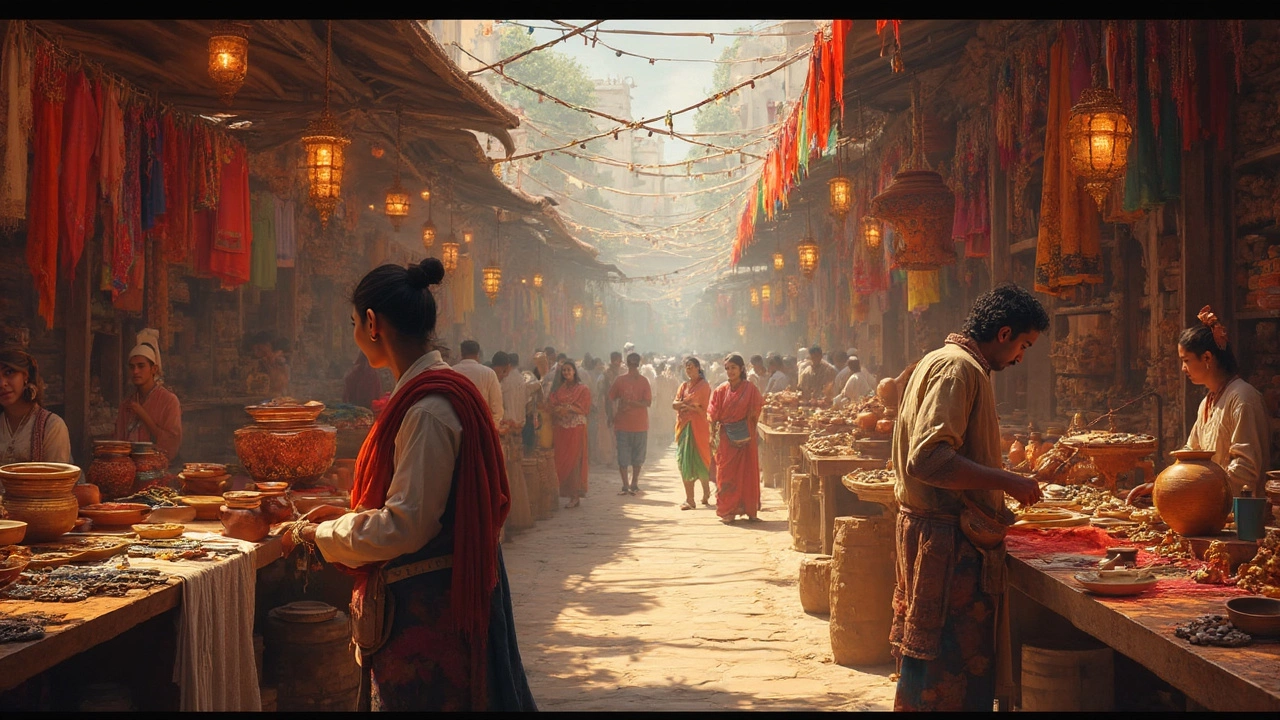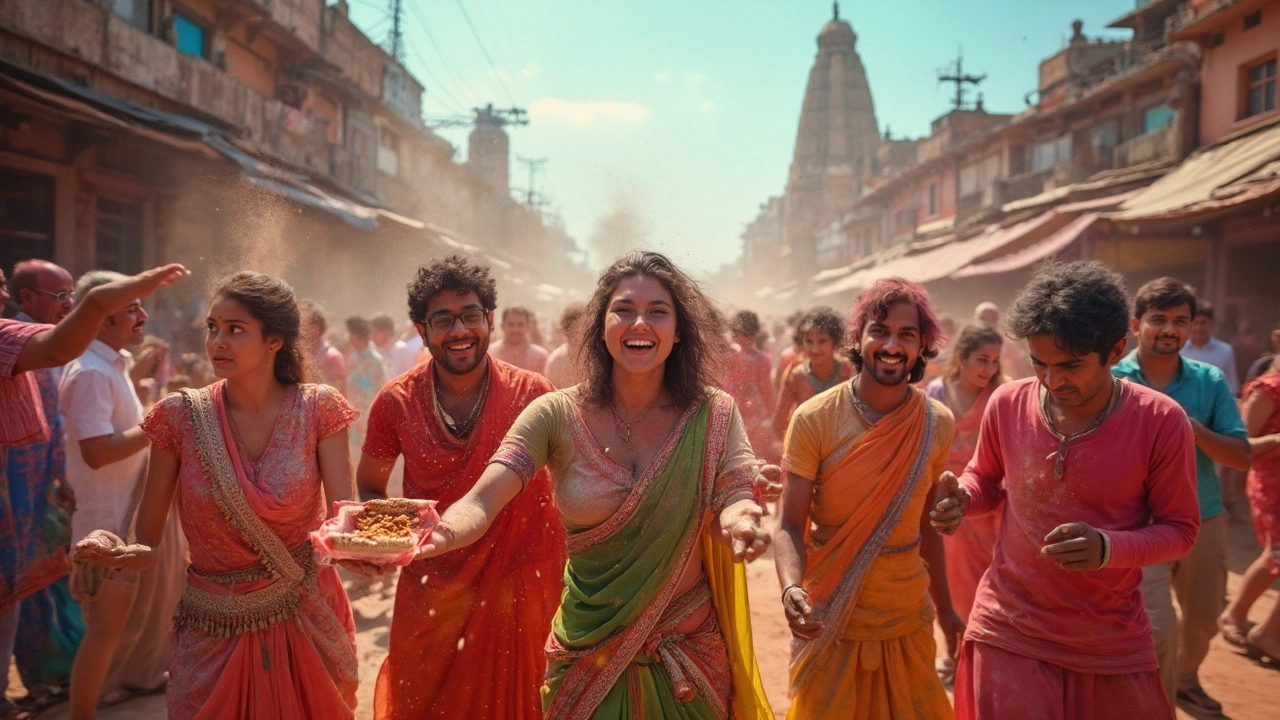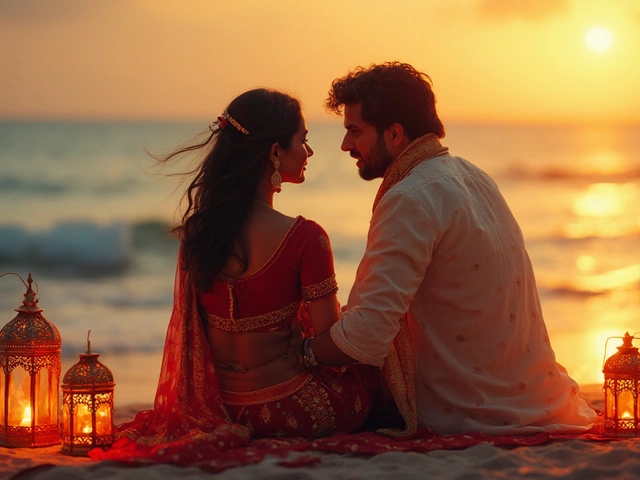India isn’t just one culture—it’s hundreds of them packed into one wild, colorful country. Planning a trip here? Get ready for jaw-dropping palaces, buzzing street parades, and food that’ll stick in your memory (and, honestly, probably on your fingers too). This place doesn’t do subtle. The biggest challenge most visitors face is figuring out what to squeeze into their trip.
If you want to see the real India, forget just ticking off monuments. Dive into the chaos of a local festival or try street snacks that locals swear by. Each state has its own scene, so you’ll never see the same thing twice. And don’t worry about sticking out—Indians love showing off their culture, and most are genuinely excited to explain what’s happening, especially if you look a bit lost during a religious ceremony or a cricket match.
- Historic Landmarks You Can't Miss
- Spiritual Hotspots and Religion
- Festivals: The Country's Biggest Parties
- Traditional Indian Arts and Crafts
- Tastes of India: Food as Culture
- Modern Culture and New Trends
Historic Landmarks You Can't Miss
If you’re checking out cultural tourism India has to offer, don’t skip the heavy-hitters. The Taj Mahal pulls in millions every year for a reason—it’s not just a famous photo spot. You’ll see why once you’re standing there, watching the white marble change from pink in the morning to gold in the evening. After all, it’s a UNESCO World Heritage Site and has even been named one of the New Seven Wonders of the World.
Old forts and palaces are scattered across the country. Jaipur’s Amer Fort mixes Hindu and Mughal styles with courtyards, secret tunnels, and mirrored halls. Delhi’s Red Fort isn’t just a pretty wall—it used to be the main home of Mughal emperors, and it’s where India’s Independence Day speech still gets delivered.
If ancient caves are your thing, check out the Ajanta and Ellora caves in Maharashtra. These aren’t just holes in the wall—there are 29 (Ajanta) and 34 (Ellora) caves packed with ancient Buddhist, Hindu, and Jain art from as far back as the 2nd century BCE. You’ll find carved Buddhas, epic wall paintings, and entire temples dug right into the rock.
Want temples? Varanasi has been a spiritual center for thousands of years. The ghats (stone steps) at the Ganges River are busy day and night with people coming to pray, bathe, or just soak up the scene. Down south, the Meenakshi Temple in Madurai is famous for its 14 colorful towers covered in thousands of statues.
- Taj Mahal, Agra: Go at sunrise or sunset for smaller crowds and better light for photos.
- Qutub Minar, Delhi: The tallest brick minaret in the world; check out the iron pillar nearby that’s stood rust-free for over 1,600 years.
- Mysore Palace, Karnataka: Decked out every Sunday night with over 97,000 lights.
- Gateway of India, Mumbai: Built to welcome the British King in 1911, now the go-to meeting spot in the city.
Here’s a quick look at how much time you might want to spend at each landmark—plan your trip so you don’t feel rushed:
| Landmark | Suggested Visit Time |
|---|---|
| Taj Mahal | 2-3 hours |
| Red Fort | 2 hours |
| Ajanta Caves | half day |
| Meenakshi Temple | 1-2 hours |
Pro tip: Most landmarks can get packed during Indian school holidays (May-June, Dec-Jan), so plan visits for early morning or late afternoon. Wear comfy shoes—lots of walking and more steps than you’d guess. And remember, these places aren’t just for tourists: locals use them for prayers, picnics, or just hanging out, so you’ll get an honest look at day-to-day life, too.
Spiritual Hotspots and Religion
India is where religion jumps off the textbook page and hits you right in the senses. It’s nearly impossible to travel anywhere without bumping into a temple, mosque, church, or gurdwara. Visiting these places connects you to Indian heritage and gives you a front-row seat to daily life.
If you’re headline-hunting, Varanasi tops the list. It’s the world’s oldest continually inhabited city, and the banks of the Ganges river are filled with chanting, fire-lit rituals, and bathers hoping for a spiritual cleanse. The Golden Temple in Amritsar is just as life-changing—grab a free meal in the world’s biggest kitchen, where up to 100,000 people eat every day, no questions asked. Down south, the Meenakshi Temple in Madurai stuns visitors with its wild, bright towers: thousands of statues painted in every color imaginable.
Hindus make up about 80% of India’s population, but that doesn’t mean it’s all about temples. Islamic architecture stands out in Delhi’s Jama Masjid and Hyderabad’s Charminar. In Kolkata, you’ll spot old churches like St. Paul’s Cathedral from the British era. The Sikh faith’s biggest hotspot is the aforementioned Golden Temple, and you’ll find Buddhist sites like Bodh Gaya, where Buddha reached enlightenment.
- Wear modest clothing and remove shoes before entering any holy place.
- Photography rules change from spot to spot—sometimes you’ll get a “no cameras” sign, other times people will ask you to join their group photo!
- If someone offers you prasad (sacred food), accept it with your right hand—it’s a sign of respect.
Here’s a quick stats check for major spiritual sites and annual visitor numbers:
| Spiritual Site | City | Annual Visitors (approx.) |
|---|---|---|
| Varanasi (Ganges Ghats) | Varanasi | 6 million |
| Golden Temple | Amritsar | 10 million |
| Tirupati Temple | Tirupati | 30 million |
| Bodh Gaya | Bihar | 1 million |
Travel tip: Many of these places fill up fast during festivals, like Diwali or Eid, so lock in your plans early if you want to see them at their liveliest. And always act with respect—these aren’t just tourist attractions, they’re living, breathing parts of India’s daily rhythm.
Festivals: The Country's Biggest Parties
If you love big crowds and color, India’s festivals blow everything else out of the water. There’s always something going on—even when you think you’ve seen it all. Cultural tourism India is often at its best in the middle of a festival. Want to know what’s really wild? Holi, the festival where everyone chucks colored powder at each other in March. You’ll be part of the action whether you want to or not. Just wear old clothes. Even teachers and taxi drivers get in on it.
Then there’s Diwali, usually in October or November. It's called the Festival of Lights for a good reason—cities and towns glow with millions of little lamps. People clean their houses, buy new clothes, and swap sweets with their neighbors. Forget quiet nights; fireworks go off almost nonstop. If you’re invited to a local’s home for Diwali, go for it. You’ll get the best sweets and a crash course in Indian hospitality.
Maybe noise and mess aren’t your thing. If you want something dramatic but a bit less chaotic, check out the Pushkar Camel Fair in Rajasthan. For a week, this small desert town fills up with camels, cattle traders, and musicians. You’ll see everything from mustache contests to acrobats, all paired with traditional Indian heritage performances.
Music and dance buffs shouldn’t skip Durga Puja in Kolkata (September/October). For almost ten days, the city builds gigantic statues and pandals (temporary temples), and the streets turn into one big open-air celebration. Everyone’s out checking costumes, art, and dancing until sunrise. It’s probably one of the best ways to experience the energy of India attractions.
- Tip: Festivals like Holi and Diwali happen all over India, but the vibe changes by region—Holi in the north is different from Holi in Goa or South India.
- Watch your wallet and keep your valuables safe in crowds. Pickpockets know festivals bring out distracted tourists.
- If you have a local contact, ask to join their celebrations. It’s the fastest way to really understand what these parties are about.
- Don’t stress about not knowing the customs—locals love explaining festival traditions.
All these festivals also mean you shouldn’t just book flights or hotels at the last minute. Everything gets crowded, especially near big temples or city centers. Skip the stress and plan ahead, especially if you want to experience unique Indian festivals up close.

Traditional Indian Arts and Crafts
If you’re into hands-on culture, Traditional Indian Arts and Crafts are hard to beat. This isn’t about souvenir shop dust collectors. Across India, skilled artists keep old techniques alive—some passed down for centuries, right in their homes or tiny workshops.
Start with textiles. Varanasi is famous for its silk saris, which can take weeks to make on handlooms. Down south, you’ll see bright Kanchipuram saris, made with actual gold threads. Pop into a market in Rajasthan and you’ll find block-printed fabric, with each stamp pressed by hand, layer by layer. If you like unique stuff, try Kalamkari prints from Andhra Pradesh—these are literally drawn freehand using a simple pen made with bamboo.
Indian pottery also has a giant following. Head to Khurja (in Uttar Pradesh) and you’ll spot blue-and-white ceramics that end up in houses all over the country. And in West Bengal, you can watch potters spin clay straight into colorful idols for festivals—they pull this off without any fancy equipment. If you're after gifts, buy something you can actually use, like a painted tea cup or bowl.
Jewelry in India could fill a museum. Jaipur is the hotspot for gems and traditional Kundan work, a style where stones are set in gold foil. You’ll see silversmiths hammering away in tiny shops, making pieces worn for weddings and daily life. Silver anklets from Gujarat and tribal jewelry from the Northeast are big draws—these designs go back generations.
- Textiles: Banarasi saris, Kanchipuram silks, block prints, Kalamkari
- Pottery: Khurja ceramics, terracotta from West Bengal
- Jewelry: Kundan work, tribal jewelry, silver anklets
If you’re curious about how these crafts are made, lots of workshops let you try your hand (sometimes literally) at weaving or block printing. Best part? You get to bring back something that’s way more meaningful than a fridge magnet.
| Craft | Main Region | Fun Fact |
|---|---|---|
| Banarasi Silk Sari | Varanasi, Uttar Pradesh | Making a single sari can take up to 15 days |
| Kundankari jewelry | Jaipur, Rajasthan | This style became popular in royal courts centuries ago |
| Kalamkari | Andhra Pradesh | Artists use only natural dyes made from plants |
Tastes of India: Food as Culture
When people talk about cultural tourism India, they usually mention the Taj Mahal or Holi paint fights. But food? It’s honestly one of the country’s biggest draws. Each region has its own flavor game, and the food changes completely every time you cross a state line. North to south, east to west, you get different spices, cooking methods, and legendary street eats that locals argue about constantly.
If you’re new to Indian food, don’t just stick to butter chicken or naan. Hit the streets for snacks like pani puri (crispy shells loaded with spicy water and potatoes) or vada pav (basically a potato burger) in Mumbai. Down south, you can’t skip dosa—thin, crunchy pancakes usually served with coconut chutney and spicy sambar.
One thing to know: Indians are serious about their spices. Your taste buds might get a shock at first, but just ask for "medium spicy" and most places will adjust. And don’t worry about eating with your hands—it’s totally normal. There’s actually a bit of technique to it. Locals believe food tastes better that way, and sometimes, they’re right.
If you want to try India’s food scene, keep these classic dishes in mind:
- Biryani: A rice and meat (or veggie) dish full of spices and cooked slow. Hyderabad is famous for this.
- Chaat: Tangy, sweet, spicy street food snacks—Delhi and Kolkata both claim to do it best.
- Idli and Dosa: South Indian breakfast classics that go perfectly with hot filter coffee.
- Tandoori: Meat or veggies cooked in a clay oven for that smoky flavor—Punjab leads the way here.
- Thali: A platter with a bit of everything—curries, bread, rice, pickle, and dessert. Great for sampling lots of flavors at once.
Cultural tip: Most Indians eat vegetarian meals way more often than you’d expect. In fact, India has the world’s largest vegetarian population—roughly 40% of people skip meat every day. Veggie doesn’t mean boring either; some of the sauciest and most flavorful dishes you’ll find here are totally meat-free.
"Food is central to Indian culture—every meal tells a story, and there’s no better way to understand a place than through its street food," says Chef Ranveer Brar, a well-known author and TV personality.
Watch for big food festivals if you want to really crank up your experience. Like the Ahare Bangla festival in Kolkata or the World Heritage Cuisine Summit in Punjab—it’s basically a playground for your stomach and a window into India’s diversity.
| Region | Notable Dish | Spice Level |
|---|---|---|
| Punjab (North) | Butter Chicken | Medium |
| Kolkata (East) | Fish Curry | Medium-High |
| Rajasthan (West) | Dal Baati Churma | Medium |
| Kerala (South) | Appam with Stew | Low |
| Mumbai (West) | Pav Bhaji | Medium-High |
So if you want to get what makes India buzz, taste something new wherever you land—your stomach will thank you.
Modern Culture and New Trends
India might be loved for its old temples, but its modern culture is turning heads across the globe. If you're walking through Mumbai or Bangalore, you'll see high-rises next to ancient shrines, hipster coffee shops, and art galleries popping up almost as fast as tech startups. Bengaluru is often called the "Silicon Valley of India" for a good reason—the city churns out software pros faster than any other place in the country.
Indian fashion is also getting bolder. Designers in Delhi and Mumbai have started blending western street style with traditional outfits, leading to the rise of "fusion" fashion. It's normal to spot teenagers wearing sneakers with a sari or a kurta paired with ripped jeans. Delhi hosts the popular India Fashion Week each year, which now draws attention from influencers worldwide.
Music isn't just about Bollywood anymore. The independent music scene exploded in the last decade with events like NH7 Weekender, which attracts audiences for genres like rock, hip-hop, and electronic. Indian hip-hop artists like Divine and Raftaar have started collaborations with international producers, and their tracks rack up millions of streams on Spotify and YouTube.
YouTubers, Instagrammers, and digital creators are quickly becoming celebrities, with vloggers like Prajakta Koli and Bhuvan Bam gathering millions of fans. Their content often blends Indian heritage and fresh trends, making them a hit with younger audiences looking for something different than the classic Bollywood style.
The food scene is also going through a tasty transformation. In metros like Hyderabad and Chennai, you'll see traditional Indian cuisine sharing space with vegan cafes and experimental restaurants serving dishes like butter chicken tacos. Delivery apps like Swiggy and Zomato have made it super simple for locals to order anything from momos to millet pizzas in minutes.
Here's how India's urban spaces are juggling the old and the new:
| City | Main Modern Trend | Traditional Element |
|---|---|---|
| Bangalore | Tech startups, craft breweries | Karnataka cuisine, historic markets |
| Mumbai | Art cafés, fusion fashion | Ganesh festival, street food |
| Delhi | Indie music, fashion weeks | Old Delhi bazaars, Mughlai cuisine |
If you want a front-row seat to India’s latest trends, check out art festivals like Kochi-Muziris Biennale or film screenings at MAMI Film Festival. And don’t be surprised if you see 5G billboards right next to ancient fort walls. That’s the real charm of cultural tourism India—it’s a mashup that actually works.


